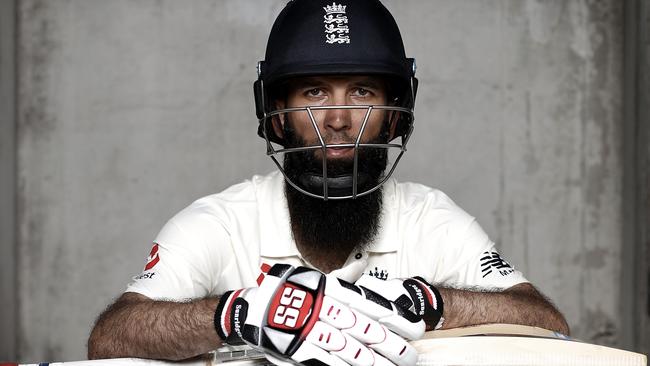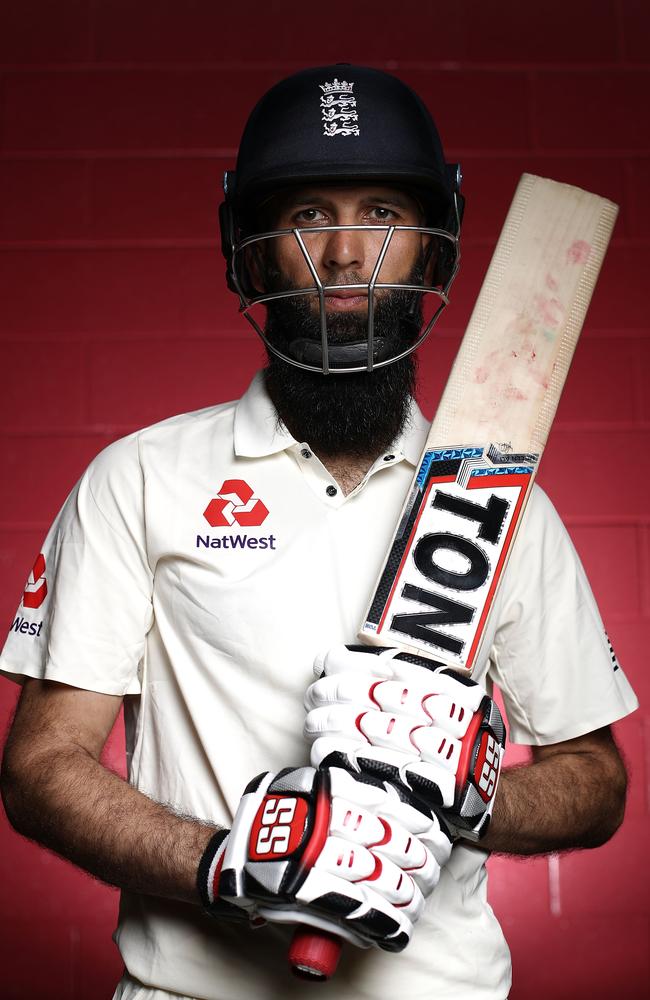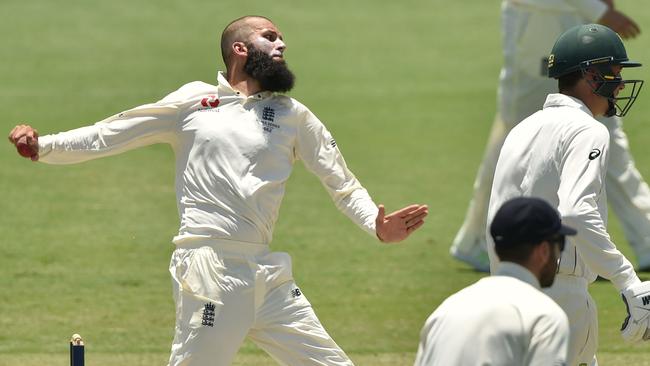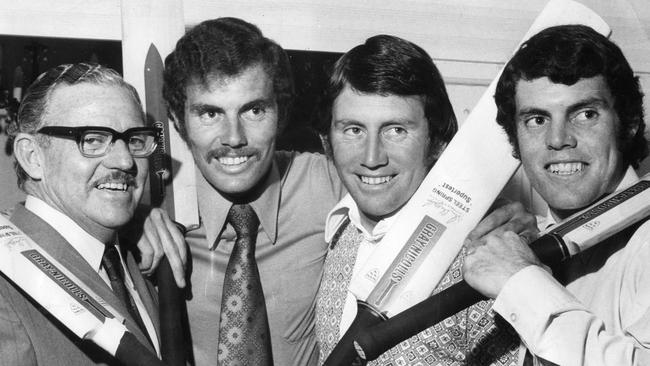Why Aussies should fear the beard
ENGLAND’S spinning all-rounder Moeen Ali could well turn out to be a trump card for Joe Root’s men this Ashes summer, writes Aussie spin great Ashley Mallett.

Opinion
Don't miss out on the headlines from Opinion. Followed categories will be added to My News.
ENGLAND’S spinning all-rounder Moeen Ali could well turn out to be a trump card for Joe Root’s men this Ashes summer. Not since the halcyon days of WG Grace has England produced a cricketer with such an impressive beard.
At New Road, Worcester’s county ground, Moeen is fondly called “the beard that’s
feared”.
Perhaps he grew the beard to help his work off the field as a role-model for fellow British Asians in getting more young Muslims to play cricket and assist those with sufficient talent to find a pathway to the top level.
I knew Moeen as an exciting, up-and-coming left-handed batsman at Warwickshire when Australia’s John Inverarity was Warwickshire coach for the three seasons, 2003-2005 and fondly remembers Moeen’s early cricket.
“At the age of fifteen Moeen Ali was in the Warwickshire Squad during the 2003 County season. He played most of the second eleven games and immediately caught the eye as a prodigious talent,” Inverarity said this week.
“Moeen reminded me of David Gower, the languid England left-hander, who timed the beautifully. In those early years Moeen seemed to be more concerned with playing great shots than with having an impact on the game: the youthful exuberance of an emerging champion. Spending almost all of my time with the County team I seldom saw him play in a match but always checked on how he played. After a time I told him I would ask him only one question. ‘How many?’
“Moeen Ali was seldom seen at the bowling crease during practices, though occasionally he sent down some medium-pacers and sometimes some off-breaks. He caught my eye one morning as he had a lovely rhythmical action with his off-breaks. Moeen as a youngster was a natural; but he was only interested in batting.”
In 2003 and 2004 Inverarity asked me to have a few sessions with him and I found Moeen to be a quiet, determined young man with a willingness to learn and work hard.
Batting seemed to come easily to him, but his off-breaks were average for he didn’t spin hard enough and as a result the ball rarely dropped with overspin and batsmen got to the pitch of his deliveries with relative ease.

He reminded me a little like Mark Waugh for whom batting seemed the most natural thing in the world, but when it came to his offies far more hard work was required. Yet Waugh bowled some vital overs in Test cricket and grabbed some big scalps. But how much a better bowler he might have been had he really worked hard at the art?
Some good judges of cricket and cricketers tell me that Moeen has improved out of sight, that he now spins the ball hard: good news for England, bad news for Australia’s lamentable players of quality spin bowling; a list that includes David Warner, Usmin Khawaja and Shaun Marsh.
Throughout the world the standard of batting against quality spin bowling has fallen to an alarming low ebb. Globally you could count on one hand the truly good players of spin. South Africa’s De Villiers, England’s Joe Root, NZ’s Kane Williamson, Sri Lanka’s adventurous stroke-maker Kusal Mendis and Australia’s Steve Smith head the list among the better players of spin.
This demise in the art of footwork and judgment of length may well have come about by two very much-aligned factors: the emergence of the frenetic wham-bam, bash whack T20 version of the game and the ICC allowing bat manufacturers to offer those tree-trunk bats for players to wield.
The stand-and-deliver type slogging we see in T20 may well have affected batsmen’s mindset and turned over to the longer form of the game. Steve Smith is one batsman who has turned his game around from the early part of his career when he played Test cricket in frenetic fashion as if he were in T20 mode. He learnt quickly and adapted.
Good footwork, however, has gone into decline. Against good spinners on a turning pitch most modern players either come forward to smother or they throw caution to the wind and hit with the tide hoping the big bat they wield will help clear the field. There also appears to be less concern about the outcome of an audacious shot which brings about their downfall. Over recent times with Australia in Sri Lanka against the spin of Rangana Hereath and England’s lamentable batting at Lord’s against Pakistan’s Yasir Shah highlights global batting deficiencies against good quality spin.
England could well do with a batsman as dogged as Geoff Boycott or Michael Atherton and another with the flair and stoke-making ability of Michael Vaughan.
Modern protective equipment is splendid, however, today we see more and more batsmen being struck in the helmet simply because they take their eyes off the ball.
Don Bradman always advocated that watching the ball right onto the bat was a non-negotiable
absolute. Before the introduction of protective batting helmets batsmen had to rely on lightning reflexes and rapid footwork to get behind to defend a fast rising ball or to get inside the line to hook in relative safety. Perhaps today’s batsmen consider themselves “bulletproof” because of the protective helmet. What has evolved from the helmet is poor technique against pace bowling and a lack of footwork against spin might be the result of big bats, short boundaries and T20 cricket.

The short form of the game has brought about short-sharp innings. Batsmen tend not to bat for long periods as they once did in Test matches. All bowlers in first-class cricket seem to be getting lots of cheap wickets because batsmen aren’t nearly so protective of their wicket as they once were when there was less cricket being played.
Ian Chappell, a masterful player of the best spin bowlers of his era, says “there are far too many rubbish theories on how to play spin bowling”.
“The sweep shot is a panacea to playing spin well. Against a good spinner the sweep is more likely to get you into trouble than help.”
In India back in 2001 Matthew Hayden decided to slog-sweep the threatening off-spin of Harbhajan Singh. He succeeded because of his hitting power and aggression.
On the other hand Harbhajan bowled in a seeming unintelligent manner. Had he changed his pace on wickets which afforded spin, bounce and variable bounce, Harbijhan would have easily won the battle against Hayden, whose stay-at-home slog-sweep should have been a path to disaster. But this was against Harbhajan Singh not a great off-spinner of the Erapally Prasanna ilk.
Many coaches advocate batsmen “stray at home” against the best spinners.
Chappelli says “the better the spinner the more positive you have to be in looking for runs and the ability to change his length by coming out of your crease or quickly going back into your stumps is crucial to keep the bowler guessing.”
He also regards spin camps on specially-prepared spin-friendly pitches a “waste of time” because a player needs to develop good technique against spin bowling at a young age.
“You don’t learn to play spin bowling when you are 25.”
When he was five years old Ian Chappell began special coaching lessons of a Sunday morning under the watchful eye of Lynn Fuller, an ex-country and AIF cricketer, who was a close friend with Ian’s parents, Martin, and Jeanne.
As soon as young Ian returned home, Martin Chappell took up the baton.
Aware that a poor delivery must be attacked he would serve up full tosses and long hops in the Chappell backyard to emphasis that a bad ball must be punished.
That was the key to future success: develop a good balance between a solid defence and a
array of attacking shots.

Those regular coaching lessons went on for 11 years, within two years of Ian playing his first Sheffield Shield match for SA.
“Young batsmen should work out their own way of playing spin bowling and practise it regularly because there are very few people who know how to coach the art properly,” Chappelli said.
“I was fortunate to have a good coach (Lynn Fuller), who taught me the correct way to use your feet and so as I got older playing spin bowling came fairly naturally.”
He maintains that a batsman has to have a plan for each spinner, for it would vary according to the bowler’s ability and the prevailing conditions.
“I was confident against spinners before I toured India, but I learned a couple of lessons there in 1969 that helped me never fear playing on a pitch that assisted spinners.
“Early on in India I learned that you had a little more time that you thought when playing back. The ball reacted much like a clay court surface compared with grass in tennis. At first I was happy for it gave me more time to defend, then I realised if you got back quickly there was time to work the ball on the on-side for runs.”
LISTEN! With the Ashes battle set to commence, we dissect the teams both on the field and in the commentary boxes and The Sun’s chief cricket writer John Etheridge gives his take on upcoming hostilities.
You can download Cricket Unfiltered from the iTunes store
Chappelli said batting against good spinners on a turning track was one of cricket’s most enjoyable challenges, but a batsman must be prepared to work hard physically and mentally.
“If you bat for any length of time in India your legs and brain should be tired by the end of the day. I am often asked why batsmen play injudicious shots in India. It usually comes about because the player does not trust his defence and consequently he lashes out in frustration. Finding a survival method for the first 15 minutes was the other lesson I learned in India but it’s easier done if you trust your defence.”
How do you compare a career of a spinner in 1960 and a spinner in 2017?
Certainly one can’t judge the bowler on the number of wickets due to the sheer weight of matches played today.
Allan Border, who hated getting out, scored 11,174 runs at an average of 50.56 in 156 Test matches, but no-one in their right mind would suggest he was superior to Don Bradman who scored 6996 runs at an average of 99.94 in 52 games.
Judging a batsman or a bowler’s career cannot then be done purely on the number of runs or wickets they stack up. As the finance writer Ron DeLegge told the world in his book inspired by the workings of Wall Street, Gents with No Cents: “99 per cent of all statistics only tell 49 per cent of the story.”
As to Moeen Ali: I bet can’t wait to bowl to Messrs Warner, Khawaja and Shaun Marsh, all left-handers, plus a few others in the Australian line-up. Nowadays Moeen has matured.
His bowling has complemented, even surpassed his stylish and dangerous down the list hitting, which has dragged England out of the mire on a number of occasions.
If he gives his deliveries a big rip, Moeen might prove a handful to Steve Smith’s men.
“The beard that’s feared” will handsomely complement the excellent pace of Jimmy Anderson and Stuart Broad on any surface Down Under.
Originally published as Why Aussies should fear the beard
